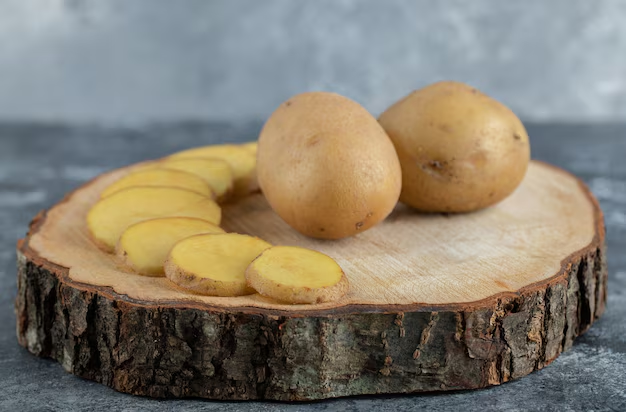How to Store Peeled Potatoes in the Refrigerator: Tips & Best Practices
Peeled potatoes are a staple in kitchens around the world, beloved for their versatility in countless recipes. But what happens when you've prepped a batch of these savory tubers, only to realize you can't use them immediately? Many cooks wonder, Can peeled potatoes be stored in the refrigerator? Let’s dig into the best practices for storing these spuds to ensure they remain fresh, nutritious, and ready for your next culinary creation.
The Case for Refrigerating Peeled Potatoes
Benefits of Refrigerating Peeled Potatoes
Refrigerating potatoes after peeling them can extend their usability, preserving their freshness for a few days. Here’s why refrigeration is advantageous:
- Prevents Browning: Peeled potatoes quickly oxidize and turn brown when exposed to air. Refrigeration helps slow down this process.
- Slows Spoilage: Cool temperatures inhibit bacterial growth, increasing the potato's shelf life.
- Convenience: Prepping in advance and refrigerating allows for quick meal assembly later on.
How Long Can You Store Peeled Potatoes?
Generally, when stored properly, peeled potatoes can last in the refrigerator for about 24 to 48 hours. Beyond this timeframe, they may begin to deteriorate in texture and flavor.
Storing Peeled Potatoes: Step-by-Step Guide
1. Submersion in Cold Water
The most effective method to store peeled potatoes is by submerging them in cold water. This helps in preventing discoloration and maintaining texture.
Steps:
- Peel and Rinse: After peeling, rinse the potatoes thoroughly to remove any dirt or residual starch.
- Submerge: Place the peeled potatoes in a bowl and cover them with cold water, ensuring they're fully submerged.
- Refrigerate: Cover the bowl with a lid or plastic wrap and refrigerate.
2. Using Acidulated Water
To further prevent browning, add a splash of lemon juice or vinegar to the water. The acid helps slow oxidation.
3. Vacuum Sealing
For those with a vacuum sealer, packaging peeled potatoes can extend their freshness significantly. Removing air limits moisture loss and browning.
Addressing Potential Pitfalls
Avoiding Texture Changes
Peeled potatoes tend to absorb water, which can alter their texture. To minimize this, use the water storage method only when necessary, and aim to utilize the stored potatoes within a couple of days.
Can You Freeze Peeled Potatoes?
While freezing raw, peeled potatoes is not typically recommended due to texture changes upon thawing, there are methods to make it work:
- Blanching First: Blanch peeled potatoes briefly in boiling water, then cool quickly in an ice bath. This helps lock in nutrients and flavor.
- Freeze Properly: Once cooled, pat dry, and place in airtight containers before freezing.
Other Potato Storage Alternatives
Storing Whole Potatoes
Whole potatoes can be stored for much longer when kept in a cool, dark place, such as a pantry or cellar, with good ventilation. Aim for temperatures around 45-50°F (7-10°C) to maximize shelf life.
Cooked Potato Storage
If you’ve already cooked the potatoes, they can be refrigerated for up to 3-5 days. Ensure they are stored in an airtight container to prevent drying out.
A Quick-Reference Summary 🌟
- 🚰 Submerge in Water: Keeps peeled potatoes from browning.
- 🍋 Add Acid: Enhance water’s protective quality with lemon juice or vinegar.
- ⏳ Use within 48 Hours: Best quality assured within two days.
- ❄️ Freeze Blanched Potatoes: For longer storage, blanch then freeze.
- 🌡️ Store Whole or Cooked Potatoes Separately: Ensure appropriate conditions for whole and cooked potatoes to maximize shelf life.
Improving Potato Quality: Additional Tips
Selecting the Right Potatoes
For optimal storage results, start with fresh, firm potatoes without any signs of sprouting or green spots. Russets and Yukon Golds are particularly versatile and hold up well in storage.
Handling and Preparation
Be gentle when peeling and slicing to avoid bruising, which can lead to quicker spoilage. Use clean utensils and work surfaces to minimize bacterial exposure.
Observations and Adjustments
Always inspect stored potatoes before use. If they appear slimy, have an off-smell, or have significant discoloration beyond typical browning, it’s best to discard them.
Exploring Related Ingredients
Consider storing other ingredients, like peeled veggies or prepped herbs, similarly to enhance meal prep efficiency. Each type of produce may have specific ideal storage conditions, but the water submersion method is commonly recommended for various tubers and root vegetables.
Hidden Benefits of Prepping Ahead
By preparing potatoes in advance and storing them effectively, you set yourself up for a quicker, hassle-free cooking experience. Whether you’re planning a big family dinner or simplifying weeknight meals, having ready-to-use ingredients can significantly streamline your process.
In essence, storing peeled potatoes in the refrigerator isn't just about keeping them from spoiling; it's about making your kitchen work smarter, not harder. With these best practices, you’ll not only save time but also ensure your culinary creations retain their intended flavor and texture.
